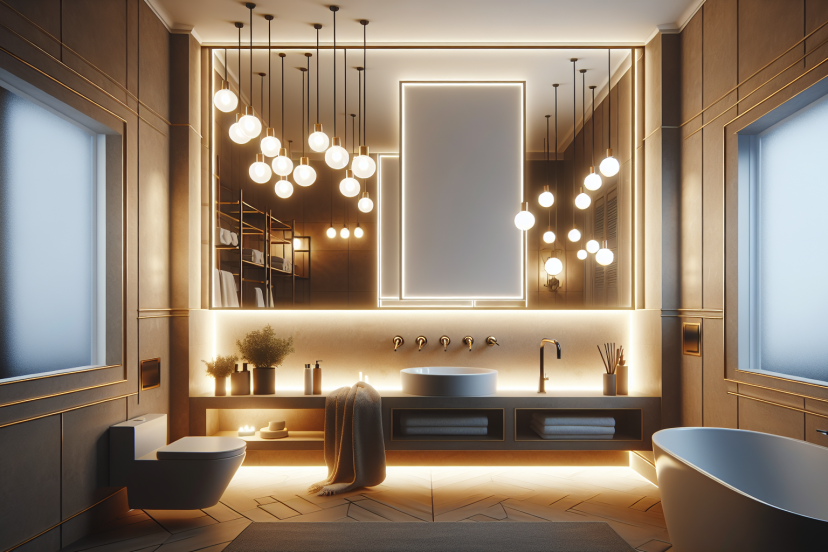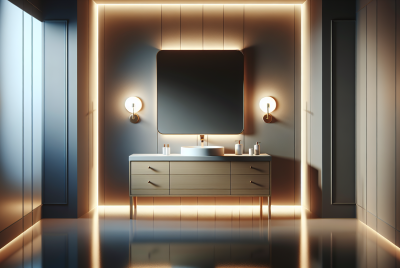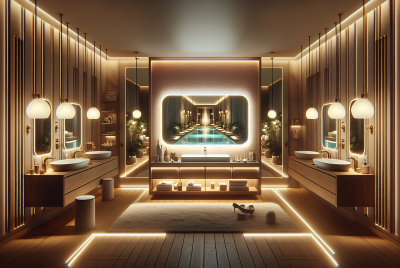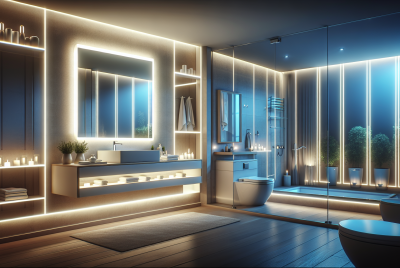How To Choose The Right Bathroom Lighting Fixtures
Choosing the right bathroom lighting fixtures can make a big difference in the overall look and functionality of your space. From the perfect vanity lights to the most suitable overhead lighting, it’s important to select fixtures that not only provide adequate illumination but also enhance the aesthetic appeal of your bathroom. In this article, we will explore the key factors to consider when choosing bathroom lighting fixtures, helping you create a stylish and well-lit oasis that meets all your needs.
Determining the Purpose and Functionality of the Lighting Fixtures
Overall Lighting Requirements
When choosing bathroom lighting fixtures, it is important to consider the overall lighting requirements of the space. Think about how much light you need in your bathroom and what activities take place there. Do you need bright, task lighting for applying makeup or shaving, or do you prefer a softer, ambient lighting for a relaxing evening bath? Understanding the overall lighting requirements will help narrow down the options for suitable fixtures.
Task Lighting
Task lighting is crucial in the bathroom, especially for activities such as applying makeup, shaving, or grooming. Consider fixtures that provide focused, glare-free light to effectively illuminate the area where these activities are performed. Vanity lights installed on either side of the mirror are popular choices for task lighting, as they provide even and balanced illumination.
Accent Lighting
In addition to general and task lighting, accent lighting can enhance the overall ambiance of your bathroom. Accent lighting fixtures are used to highlight specific architectural features or decor elements, creating visual interest and depth in the space. Wall sconces or pendant lights strategically placed can add a touch of elegance and drama to the bathroom.
Considerations for Bathroom Size and Layout
Large Bathrooms
Large bathrooms offer more flexibility when it comes to lighting choices. In these spacious settings, it is recommended to combine different types of fixtures to create a well-balanced lighting scheme. Consider using a combination of ceiling mount fixtures, vanity lights, and wall sconces to ensure adequate lighting and a cohesive design.
Small Bathrooms
In small bathrooms, space may be limited, but that doesn’t mean you have to compromise on style or functionality. For these compact spaces, it is important to choose fixtures that are not only visually appealing but also provide ample lighting. Recessed lighting is a great option for small bathrooms, as it provides a sleek and streamlined look while maximizing the available space.
Open Layouts
If your bathroom has an open layout, meaning it is connected to an adjacent room such as a bedroom or a dressing area, it is important to consider the overall design and lighting scheme of the entire space. Choose fixtures that complement the style and function of both areas, ensuring a seamless flow and cohesive look.
Closed Layouts
Closed layouts, where the bathroom is separate from other rooms, allow for more privacy and flexibility in lighting choices. You can focus on creating a lighting scheme specifically tailored to the bathroom, without worrying about how it integrates with other areas. Wall sconces and pendant lights can add a touch of elegance and create a cozy atmosphere in closed layouts.
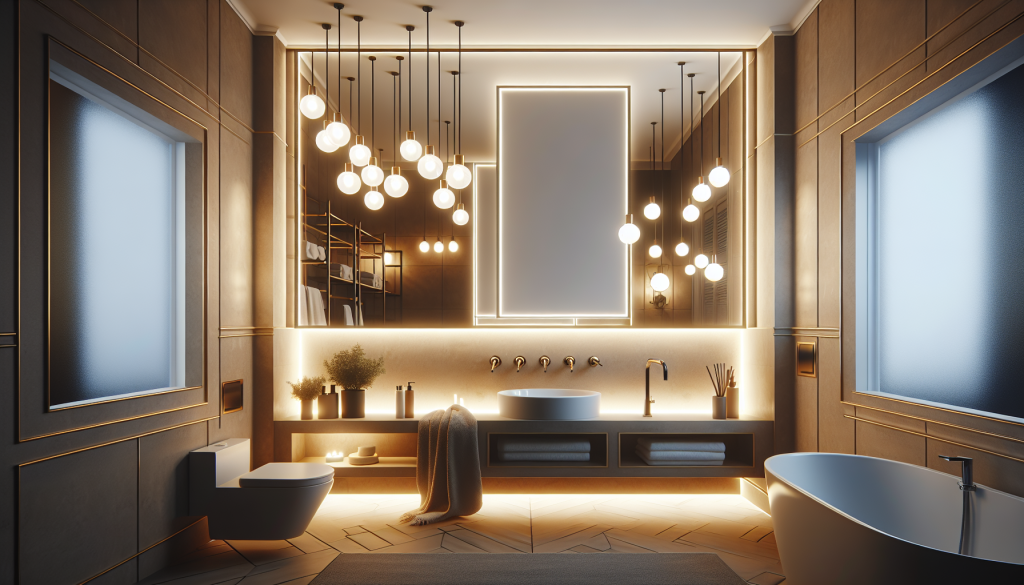
Understanding Different Types of Bathroom Lighting Fixtures
Ceiling Mount Fixtures
Ceiling mount fixtures, such as flush mounts or semi-flush mounts, are excellent choices for providing general lighting in the bathroom. They are installed directly onto the ceiling, offering bright and even illumination throughout the entire space. Ceiling mount fixtures come in a variety of styles and designs, making it easy to find one that suits your personal taste and bathroom decor.
Vanity Lights
Vanity lights are essential for task lighting in the bathroom. These fixtures are typically installed above or on either side of the bathroom mirror to provide even and shadow-free lighting for grooming and makeup application. Vanity lights come in various configurations, including single sconces, multi-light bars, or even vertical strip lights.
Wall Sconces
Wall sconces are versatile fixtures that can be used for both general lighting and accent lighting purposes. They can be installed on the walls to add a decorative element to the bathroom while providing supplementary light. Wall sconces come in a wide range of designs, from traditional to modern, allowing you to choose one that complements your bathroom’s style.
Pendant Lights
Pendant lights are stylish and versatile fixtures that can add a touch of drama to the bathroom. They are suspended from the ceiling and can be used for both general lighting and accent lighting purposes. Pendant lights come in various shapes and sizes, making them suitable for different bathroom sizes and styles. Consider using pendant lights above a freestanding bathtub or in a large bathroom with high ceilings to create a focal point.
Recessed Lighting
Recessed lighting, also known as can lights or downlights, is a popular choice for both small and large bathrooms. These fixtures are installed into the ceiling, creating a clean and minimalist look. Recessed lighting provides focused, directional light and can be used for general lighting, task lighting, or accent lighting purposes. It is important to plan the placement and spacing of recessed lights to ensure even and adequate illumination.
Exploring Various Lighting Sources and Bulbs
Incandescent Bulbs
Incandescent bulbs are the traditional choice for bathroom lighting. They provide warm and soft light, creating a cozy and inviting atmosphere. However, incandescent bulbs are not as energy-efficient as other options and have a shorter lifespan.
Halogen Bulbs
Halogen bulbs are an improved version of incandescent bulbs, offering a brighter and whiter light. They are known for their high color rendering index (CRI), which means they can accurately reproduce colors. Halogen bulbs are more energy-efficient than incandescent bulbs but still consume more energy than other options.
LED Bulbs
LED bulbs are highly energy-efficient and have a long lifespan, making them a popular choice for bathroom lighting. They produce a bright, cool light and are available in a range of color temperatures to suit different preferences. LED bulbs are also dimmable, allowing you to adjust the intensity of the light as needed.
Fluorescent Bulbs
Fluorescent bulbs are known for their energy efficiency and long lifespan. They produce a cool, white light and are often used in commercial or industrial settings. However, fluorescent bulbs may not be the best choice for bathrooms where color accuracy is important, as they have a lower CRI compared to other options.
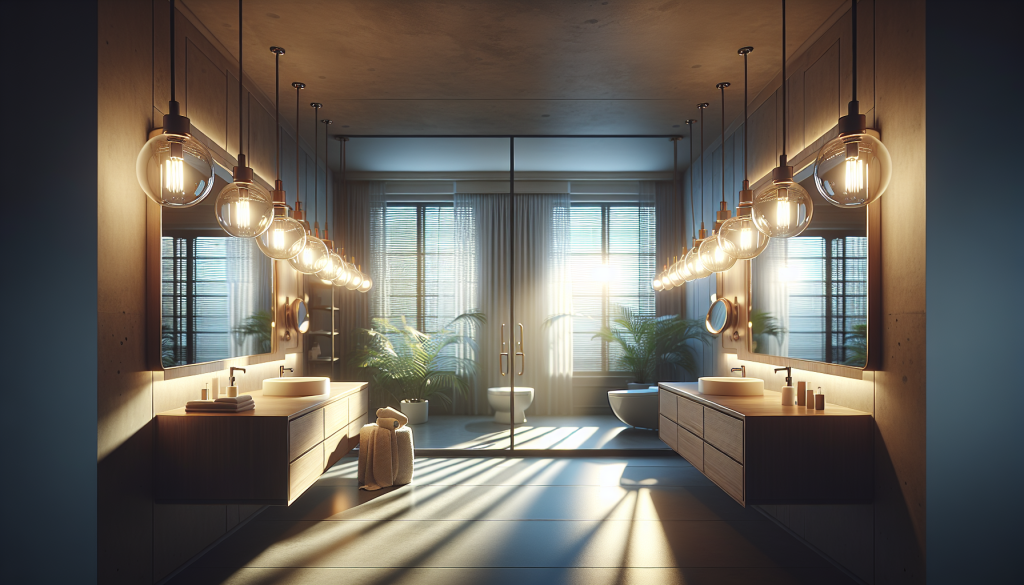
Choosing the Right Color Temperature for the Lighting
Warm White
Warm white light has a yellowish hue and creates a cozy and inviting atmosphere. It is ideal for bathrooms where relaxation and comfort are desired, such as master bathrooms or spa-like retreats. Warm white light can also complement warmer color palettes and traditional bathroom styles.
Cool White
Cool white light has a bluish-white hue and provides a bright and crisp illumination. It is suitable for bathrooms where functionality and visibility are important, such as powder rooms or bathrooms used for grooming. Cool white light can also enhance modern or contemporary bathroom designs.
Daylight
Daylight, also known as natural light, replicates the light spectrum of the sun. It provides the most accurate color representation and is ideal for bathrooms where true color rendering is important, such as bathrooms used for makeup application or hair styling. Daylight bulbs can simulate the feeling of natural light, even when there are limited windows or access to natural light in the bathroom.
Optimizing Energy Efficiency
Energy Star Certified Fixtures
Choosing bathroom lighting fixtures that are Energy Star certified can contribute to energy efficiency and reduce electricity costs. Energy Star certified fixtures meet strict efficiency standards, consuming less energy while still providing adequate lighting. Look for the Energy Star label when selecting your fixtures.
Dimmable Lights
Installing dimmable lights in your bathroom allows you to adjust the intensity of the light according to your needs and preferences. Dimming the lights not only creates a more relaxed and cozy atmosphere but also reduces energy consumption. Consider using dimmable LED lights, as they offer the greatest level of control and energy efficiency.
Automatic Sensor Lights
Automatic sensor lights are a convenient and energy-efficient option for bathrooms. These lights are equipped with motion sensors, so they turn on automatically when someone enters the bathroom and turn off when the room is empty. They are especially useful for guest bathrooms or powder rooms, where lighting may be inadvertently left on.
Natural Lighting
Maximizing natural lighting in your bathroom is not only energy-efficient but also beneficial for your well-being. Consider incorporating windows, skylights, or light tubes in your bathroom design to allow natural light to flood the space. Natural light can enhance the overall aesthetic of the bathroom and create a sense of openness and freshness.
Considering Style and Aesthetic Appeal
Traditional
For a classic and timeless look, consider traditional-style bathroom lighting fixtures. Traditional fixtures often feature intricate details, such as scrollwork or ornate elements. Opt for finishes like brushed nickel or bronze to complement the traditional bathroom style. Vanity lights with fabric shades or wall sconces with candle-like bulbs can add a touch of elegance to the space.
Modern
Modern bathroom lighting fixtures are characterized by clean lines, sleek designs, and a minimalist aesthetic. Choose fixtures made of materials like chrome or stainless steel for a contemporary look. Look for vanity lights or pendant lights with geometric shapes or LED strip lights for a modern touch.
Industrial
Industrial-style bathroom lighting fixtures are inspired by the look of factories and urban lofts. They often feature raw materials like metal and exposed bulbs. Look for fixtures with galvanized steel or aged bronze finishes. Wall sconces with metal cages or pendant lights with reclaimed wood accents can add an industrial vibe to your bathroom.
Vintage
For a nostalgic and charming look, consider vintage-style bathroom lighting fixtures. Look for fixtures with retro-inspired designs or finishes like brushed brass or aged copper. Vintage vanity lights with milk glass shades or wall sconces with Edison bulbs can add a touch of vintage elegance to the space.
Transitional
Transitional bathroom lighting fixtures blend elements of traditional and modern designs to create a balanced and versatile look. They often feature simple and clean lines with minimal details. Choose fixtures with finishes like brushed nickel or black for a transitional look. Vanity lights with frosted glass shades or wall sconces with clean silhouettes can complement the transitional style.
Rustic
Rustic-style bathroom lighting fixtures showcase natural materials and earthy tones. Look for fixtures made of wood or metal with distressed or textured finishes. Rustic vanity lights with mason jar shades or wall sconces with antler accents can create a cozy and rustic atmosphere in your bathroom.
Understanding IP Ratings for Bathroom Lighting
IP23
IP23 rated fixtures are suitable for use in bathrooms but are recommended for areas where water splashes are less likely, such as further away from the sink or bathtub. These fixtures offer protection against water spray up to 60 degrees from vertical but are not suitable for direct contact with water.
IP44
IP44 rated fixtures are designed for use in bathrooms and provide protection against water splashes from any direction. These fixtures are suitable for areas near the sink or vanity where water exposure is a possibility. It is recommended to use IP44 rated fixtures in wet locations such as showers or directly above bathtubs.
IP65
IP65 rated fixtures are specifically designed for use in wet locations in bathrooms where direct or heavy water exposure is expected. These fixtures provide complete protection against water jets from any direction, making them ideal for use in shower areas or above bathtubs.
Considering Safety and Water Resistance
Damp Location Rated Fixtures
Damp location rated fixtures are designed to withstand moisture and humidity in bathrooms. They are suitable for areas that are not directly exposed to water, such as above vanities or on walls away from bathtubs or showers. Damp location rated fixtures provide an extra level of protection to prevent damage from moisture.
Wet Location Rated Fixtures
Wet location rated fixtures are specifically designed to be resistant to water and can be safely used in areas of direct water exposure, such as showers or saunas. These fixtures are sealed to prevent water from entering the electrical components, ensuring safety and longevity.
Waterproof Ratings
Waterproof ratings are important when it comes to fixtures used in areas with direct water contact, such as above bathtubs or inside showers. It is important to ensure that the fixtures have the appropriate waterproof rating to prevent any electrical hazards. Always check the manufacturer’s specifications and consult with a professional to ensure the safety and suitability of the fixtures for your specific bathroom needs.
Seeking Professional Advice and Assistance
Consulting with an Electrician
Choosing the right bathroom lighting fixtures involves electrical considerations that are best left to the expertise of a licensed electrician. They can assess your electrical system, recommend appropriate fixtures, and ensure safe installation. Consulting with an electrician can help you navigate the technical aspects and ensure your bathroom lighting is both functional and safe.
Working with an Interior Designer
An interior designer can help you create a cohesive and aesthetically pleasing bathroom lighting design. They can assist in choosing fixtures that complement your overall design style and provide guidance on placement and arrangement. Working with an interior designer can help you achieve a well-designed and visually appealing bathroom space.
In conclusion, selecting the right bathroom lighting fixtures involves careful consideration of the overall lighting requirements, bathroom size and layout, types of fixtures, lighting sources and bulbs, color temperature, energy efficiency, style and aesthetic appeal, IP ratings, safety, and seeking professional advice. By taking into account these factors, you can create a well-lit and beautiful bathroom that meets your functional and design needs. Remember to prioritize safety, energy efficiency, and personal style to achieve the bathroom of your dreams.

